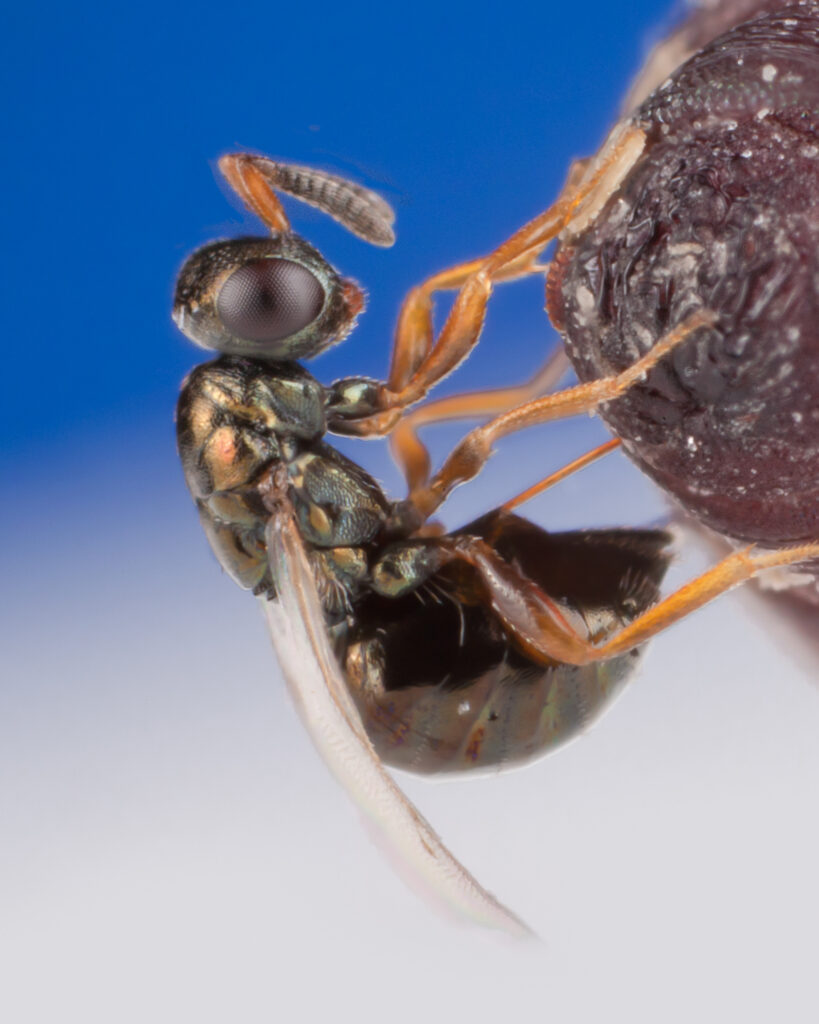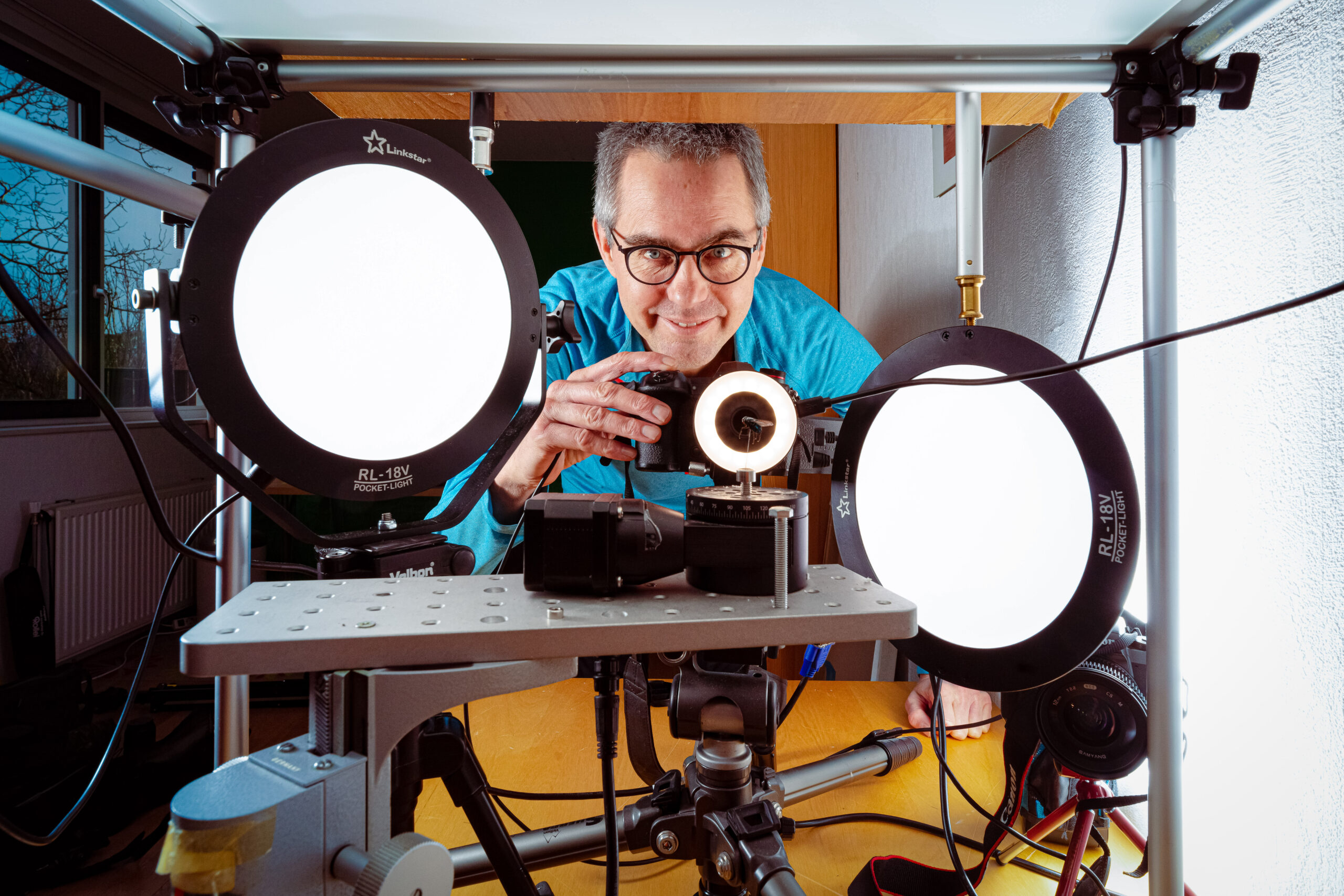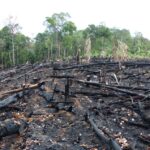The coronavirus crisis has given entomologist Hans Smid more time to pursue his hobby: recording insect behaviour. On film now too, and with amazing results.

On close inspection, the life cycle of the parasitic wasp Cotesia glomerata is a horror story. Researcher Hans Smid captured it in a film precisely two minutes long, which can be watched on his new website Bugsinspace.nl. The parasitic wasp lays its eggs in the larva of a large cabbage white butterfly, where they develop into larvae and eventually penetrate the skin of the adult caterpillar to emerge into the outside world. The film has a high yuck factor. ‘It’s ghastly,’ admits Smid. ‘You don’t normally see it because it takes place on a micro scale. The caterpillar gets devoured from the inside out.’ But then something strange happens. The caterpillar appears to come out of this adventure unharmed. In fact, she looks after the wasp larvae as if they were her own brood. How weird is that? ‘Parasitic wasps manipulate their host’s behaviour,’ explains Smid. ‘Viruses that come with the eggs probably play a role in that. They hamper the host’s immune response and change the behaviour of the caterpillar once the larvae have hatched. In fact, the wasps turn the caterpillar into a zombie.’
Hans Smid has been doing research on the fascinating behaviour of parasitic wasps ever since he got his PhD . He focuses specifically on the learning behaviour of parasitic wasps. Some species learn fast while others are slow learners. He found an explanation for that difference through neuroethological research.
This is all quite unconventional for a career that started in the lab after Smid trained as a lab technician in the mid-1980s at the then Van Leeuwenhoek Institute in Delft. He proved to be allergic to the lab animals that were then in standard use. ‘I did one week of an internship at TNO, working with rats and mice, and it affected my lungs.’ What then? In Wageningen he could work with insects. ‘At least they are not furry animals, so I thought I would be able to do that. It went fine for two years, and then I started to be affected by those Colorado beetles.’
Burnout
By then his internship had already led to a permanent job as an analyst. He was even given the chance to do research himself and to get a PhD. ‘It was fundamental research on the regulation of reproduction in Colorado beetles. On how it works, and which substances (sex peptides) are involved.’ Smid got his PhD in 1998 in a period of major reorganizations at the university. ‘More than half the chair group staff left, including my co-supervisor. I got to stay, and I got involved in the research into the learning behaviour of parasitic wasps. It was an added advantage that I wasn’t allergic to them.’
Smid’s career progressed smoothly until 2016, when he had a burnout from which he never fully recovered. ‘I now work as a lab manager for a total of three days a week. But I can’t carry on with my research. I can no longer concentrate for long on academic literature, writing, or on teaching and practicals. I couldn’t possibly spend the whole day on Zoom, the way people are doing now in Covid times.’
To make good use of his time, Smid moved his photo studio from the campus to his house in the centre of Wageningen. ‘At least that is work I can do without overdoing things.’ By studio, Smid means all the equipment he’s been using for over 10 years to take the most fantastic photos of insects. Macro photos which portray the insects larger than life. ‘It started in 2000 when I bought a digital camera for my microscope. It could take macro photos too and I used it to take my first photo of a parasitic wasp. Wow! That was beautiful – and easy.’
‘One thing led to another. We got another camera and then another, and it kept getting better and better. Two of my colleagues and I started the website bugsinthepicture.’ A few years ago, though, his situation forced him to give up that website. Now, with bugsinspace.nl, Smid has a new home on the Internet. ‘It’s a working title, actually. I thought it up in five minutes. I was thinking of insects in 3D, because you can look at my panorama-mode photos of the insect from all sides. I needed a catchy phrase to make those interactive shots and films accessible.’ Because this is something new: Smid photographs insects from all sides and films them as well.
Complicated
The step from photographs to videos is not as big as it might seem, he says. ‘There used to be totally different cameras for photography and video. That is no longer the case. I have a Panasonic that is used by professionals too. It switches easily between photos and video and there’s a natural flow from one to the other. You use the same lens, and the same lighting with LED panels. You don’t need flash anymore. You can photograph perfectly with LED lights.’
There used to be totally different cameras for photography and film. That’s no longer the case
One big difference is the depth of field. ‘A lack of focus in a photo is often very obvious and I solved that using the focus-stacking technique to superimpose dozens of photos on each other. In a film, a slightly fuzzy section is not such a problem because the subject is moving. But because of that movement you do have to be refocusing continuously. You can’t use the autofocus for that; it’s too slow and imprecise. The macro lenses that I use the most don’t even have autofocus. So you have to do that manually. I operate my camera on a rail system. Using a touchscreen, I can move the camera to and fro very precisely. I use my other hand to do the same with the tray I’ve got the insect on. And I follow the result on a monitor.’
That sounds complicated, and it is. ‘I very often have to do it again before I get a good picture. There are a lot of failures. For example, I still haven’t got a good film of a mosquito biting. Either I’m just too late, or my hand that the mosquito is on moves a bit too much, or the mosquito refuses to bite time after time. It goes wrong 100 times before it works once.’
I want to get a picture of animals and their behaviour in a way that is ethical
‘What I want is to get a picture of animals and their behaviour in a way that is ethical,’ is how Smid describes his goal. ‘I am not a typical nature photographer who will spend an hour lying on his front in the water meadows to get that one shot. I work indoors, I have a technical approach, and my main aim is to get a picture with the sharpest focus possible.’ And yes, he does manipulate the photos, admits Smid. ‘You are already doing that when you arrange the creatures in front of your camera in a way that will make them display the behaviour you want to get a good picture of. But the behaviour they display is natural: this is how they go about things. And you can only manipulate an insect to a certain extent. The bug just follows its instincts.’
It goes wrong 100 times before it works once
Not just beautiful
Smid’s work has become more than a nice hobby by now. ‘I provide my colleagues with a lot of material. Those interactive shots are very useful in practicals. A picture says more than a thousand words and that works on several fronts. Insects are incredibly photogenic, which is something you should make good use of in presentations, in teaching and for PR purposes. It is so nice to be able to show the behaviour you’re going to talk about at the beginning of a presentation. It grabs people’s attention straightaway.’ But the images are not just beautiful, they also provide new information. For example, for one of his colleagues, Smid filmed the behaviour of male parasitic wasps whose sexual development was inhibited by RNAi. ‘Their behaviour looked normal, and yet they were not capable of impregnating females. Only by filming at high speed and then watching the films one after the other in slow motion could you see the subtle differences in mating behaviour. You would never have seen that with the naked eye.’
Smid’s work is much appreciated by his colleagues. Would he like to do more of this? ‘The big problem is that it is enormously time-consuming work,’ Smid responds cautiously. ‘So it’s very expensive if you get paid for all those hours. Plus, even photography involves a lot of computer work. I really have to watch out that I spread my energy evenly over the day. It’s easy to do too much and you only notice that when it’s too late. For the time being, it’s a welcome change from my normal work. Especially now, in Covid times.’

 ‘I am not a typical nature photographer who will spend an hour lying on his front in the water meadows to get that one shot’. Photo: Erik Scholten
‘I am not a typical nature photographer who will spend an hour lying on his front in the water meadows to get that one shot’. Photo: Erik Scholten 

